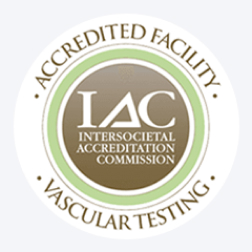Understanding Vein Conditions
What Are Vein Conditions?
Vein conditions affect how blood flows through the veins in your legs and feet. Healthy veins contain one-way valves that help blood travel upward to the heart. When these valves weaken or fail, blood can leak backward and pool in the lower legs, a problem known as venous reflux.
Over time, this buildup of pressure can stretch and damage the vein walls, leading to visible varicose veins, swelling, discomfort, and other symptoms. Left untreated, vein disease can progress and impact your overall circulation and mobility.
Understanding how your veins function — and what happens when they don’t — is the first step toward preventing complications and getting effective care.

Request a Consultation

Why Vein Health Matters
Your legs contain both superficial and deep veins that work together to return blood to your heart against gravity. When these veins aren’t functioning properly, circulation slows, and the muscles, skin, and other tissues in your legs don’t receive the oxygen and nutrients they need to stay healthy.
Poor vein health can cause:
- Persistent swelling or heaviness in the legs
- Skin changes and irritation
- Restless legs and nighttime cramps
- Fatigue and aching after standing or sitting for long periods
- Ulcers or slow-healing wounds near the ankles
These symptoms can significantly affect comfort, appearance, and daily activity — but they’re also highly treatable once identified.
Common Vein Conditions
Enlarged, twisted veins that often appear on the legs or feet. They form when valves in the veins stop working properly, allowing blood to pool. Varicose veins can cause aching, throbbing, and swelling, and may worsen without treatment.
Learn moreA long-term condition in which weakened vein valves allow blood to collect in the legs. CVI can lead to swelling, pain, discoloration, and in severe cases, open sores called venous ulcers.
Learn moreA neurological condition that can be linked to poor circulation and vein disease. Patients often experience an uncontrollable urge to move their legs, especially at night, leading to poor sleep and discomfort.
Learn moreA serious condition in which a blood clot forms in a deep leg vein. DVT can cause sudden pain, warmth, and swelling and requires immediate medical attention to prevent potentially life-threatening complications.
Learn moreEnlargement of veins within the scrotum, similar to varicose veins in the legs. Varicoceles can affect fertility and may cause pain, heaviness, or swelling.
Learn moreWhen to See a Vein Specialist
If you have persistent leg pain, swelling, or visible veins, it’s time to consult a specialist. Early evaluation can:
- Identify underlying venous reflux before complications occur
- Prevent ulcers and skin changes
- Improve comfort, mobility, and appearance
- Help you return to daily activities without discomfort
At United Vein & Vascular Centers, our board-certified vein specialists provide accurate diagnostics and minimally invasive treatment options tailored to your unique needs.
